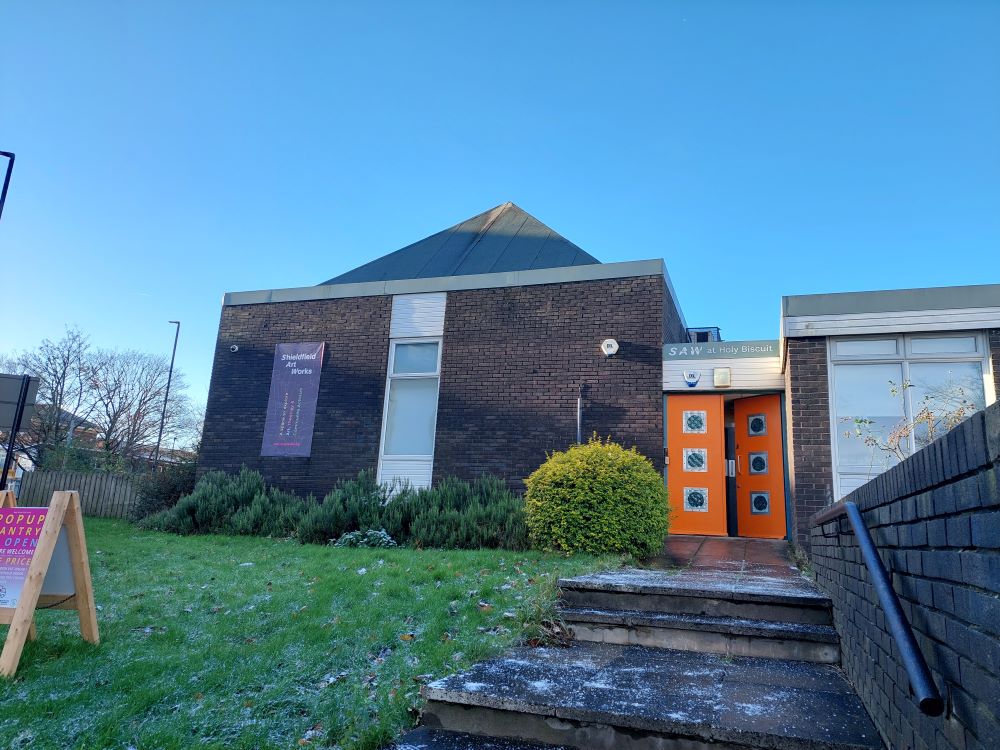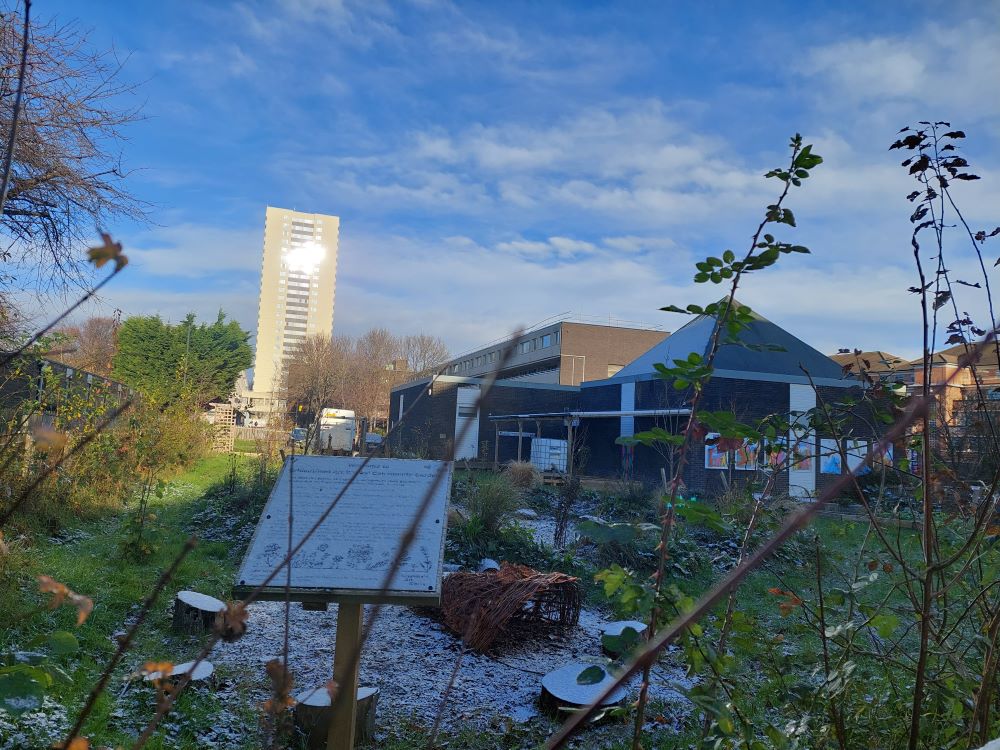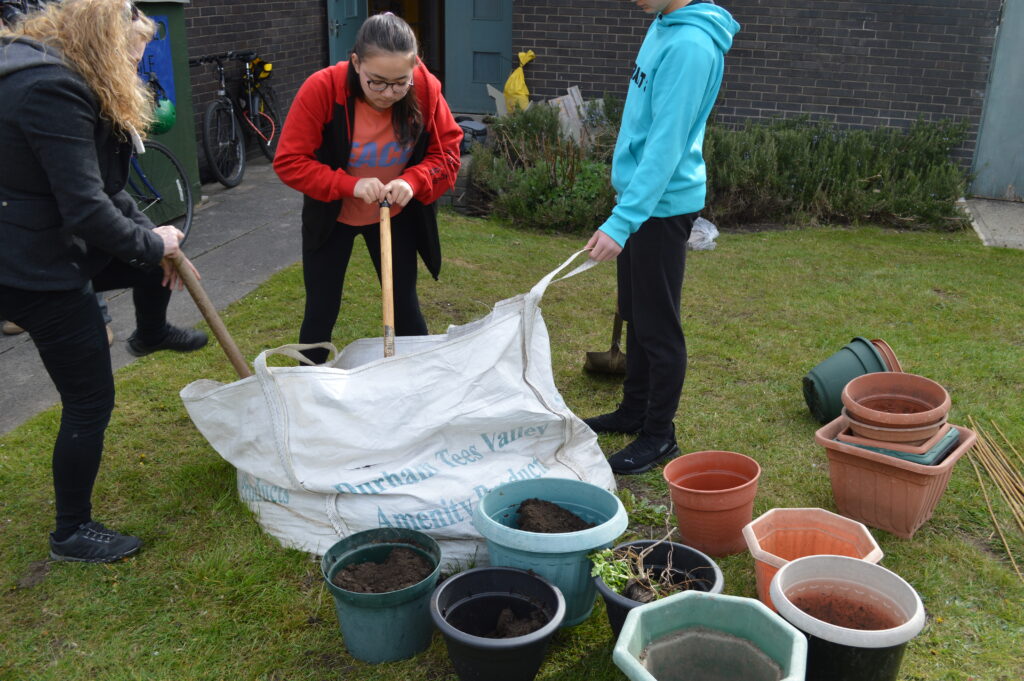A conversation with Lydia Hiorns:
Emily: How and why did the organisation start?
Lydia: We are a project of the Methodist church, this building used to have a congregation who worshipped the Methodist church. They were debating what to do with the land. There was an opportunity to sell it off as student accommodation. I’m not sure if you’re aware of the area but there’s already lots of student accommodation and it’s really had a significant change on the way the community is. A lot of it was built without any thought or conversations with the local residents and what these sites would be used for. So, I think it was important for the Methodist church to use this site for community and the flourishing of this area. And so, with us also being in the arts quarter, we thought it would be really great to use this as an arts space for the community and that’s kind of how the idea came about.
Some money from the Biscuit Factory was put in to turn this into a gallery and workshop space. From the start, it was very much – artists would come in, pay some money and have exhibitions. It was a bit more contractual whereas now, we have developed into an exhibition area catered to the local area. The themes we work around in our exhibition programme are all around what is going on in this area, giving a platform to those voices who aren’t generally heard. Or are not heard as much as those who have money.
So, that’s kind of how it all began. And we changed our name three or four years ago from the Holy Biscuit to SAW [Shieldfield Art Works] as we wanted what we do here to represent what we are […]. Shieldfield is often left off many maps and so we wanted our name to have it in. We see art as an integral part of our organisation. It’s an articulation of lived experience of what we all experience as humans. That’s kind of, in a nutshell, how it all began.
“But also, artworks can work for good and bring back positive change in the way people think and the way people are activists creatively.“
Cameron: I know that you said that the charity started out as a Methodist organisation, but you’re also involved with the garden as well as the art shows the organisation puts on. Are there any challenges being involved with so many different things?
Lydia: Yes, you feel like you’re wearing a lot of different hats. So we’re interested in how our faith and community activism work together and the different tensions between those and how they interweave. And that for us is why we’re here and what we’re interested in.
But the difficulties with [it] are that often those three spheres, in society, don’t generally talk to each other. I guess you could call it pioneering work in the sense that I don’t really know any other organisations who are trying to merge those three things together. So it is very much trial and error, and that is important to us. I think often in our society and even in the art world, you just have to continually produce and succeed and if something fails it’s seen as a negative. But for us, if we try something and it doesn’t work that’s actually okay. You learn from that, and you change the way you go about doing something.
I guess the other tension and difficulty is because we are part of the Methodist church and we are also working in the art world, whilst also doing our community activism with the local residents. All those different bodies of people […] have different ways of thinking and different needs. Sometimes it feels very stretching to try and please everybody; how we work with all these different groups of people, and how they have differing thoughts about how different things work.
Emily: Do you have an example of where that friction has occurred?
Lydia: I think an example would be, […] when you are trying to write a funding bid, for example, to an arts organisation that can provide funds or trying to write one to a Christian organisation that can provide funds. They want different things and so sometimes, the Christian organisations don’t necessarily get the arts and the arts organisations don’t understand the Christian faith aspect. So, there have been times where we have found it hard to get funding because they are struggling against each other.
“We believe art should be for all people, no matter your class, background, or culture. It should be accessible for all.“
[We want to] allow the community we are working in to feel comfortable in our space. At some events, you would often […] have wine and cheese nights. But, for a lot of people we work with in the community, perhaps alcohol is not something they want or can be quite dangerous for people with a history of alcohol abuse. Or it’s not something that they want to have in their culture. Or quite often, wine and cheese nights just seem quite fancy and a bit snooty. So, within that regard we don’t do wine and cheese nights anymore, we do bring-and-share meals. So, it’s trying to think about how those [multiple] spheres work together.
Emily: I think you’re also answering another question we had about what the gifts of the intersections of your work are. Is there anything you would want to elaborate on about the highs or maybe the gifts of that?
Lydia: I just love the different people we work with.
“I love that there are so many different perspectives and thoughts that we get to have a conversation with. […]”
For example, the exhibition space, we want that to be an open space where open conversations can happen. I think often people are in their own echo chambers and they won’t listen to those around them, they’ll just talk past each other. People aren’t good at disagreeing well and so what we want from our space is for people to be able to disagree and to be in a community able to do that.
Especially within Shieldfield we have so many different cultures and backgrounds. I think that, for me, is a real gift and a joy to be able to hear lots of different people’s thoughts. In the local primary school, I think there are 27 different languages spoken, so having perspectives from people who have been through quite harrowing experiences, whilst also hearing their stories about the countries they come from is something I particularly love as part of the work we do here.

Cameron: […] In terms of your own personal experience of working at SAW, are there any highs or lows that you’ve experienced that you maybe wanted to touch on?
Lydia: I used to work with two people. I worked with Ken who is a community member on the growing programme, so I helped lead that as the collaboration between SAW and Dwellbeing Shieldfield. At the time Ken was with Dwellbeing Shieldfield. I loved working with Ken, she has such a heart for the community. She made me laugh a lot. I just loved the collaboration with her and that it was coming from two organisations who are working with and for the community, but don’t necessarily live here. [Although] Ken was living here, and she knew everybody, I loved that. And now Kaltouma, who has taken over from Ken – it’s very similar, she has a big heart for this community. And loves the growing work. So, I think that for me that has been one of the highlights.
I also just love curating exhibitions and thinking about how we explore different ideas. There’s this quote I think about, art kind of creeps past people’s dragons and preconceptions and gets them to actually really seriously think about issues they might have just had a preconception about.
“And I think that’s what art does, it opens people up to see things in different ways and talk about it.“
Emily: What art projects have you done that have been the most eye-opening for people’s preconceptions?
Lydia: […] We try to think about the issues that are happening currently in Shieldfield. So, one of the exhibitions we did was called Prospect Us and that was all [about] what has happened in the area, who owns the land, who has the right to say what happens to the land and who has the right to change a community. And that was really eye-opening because in the room and in the exhibition we had residents, artists, town planners and architects. People from all spheres kind of talking to each other. […] Over the past four or five years we’ve been looking at land and the ethics of land. I’ve learnt so much about how that affects people, it’s one of the main issues in the UK now, how it affects the housing crisis, refugees and asylum seekers and economics. I’ve learnt a lot about that.
We also had an exhibition recently called Bee Lines Through The City. That was looking at the overarching climate crisis, but specifically from the point of view of bees and how they are affected by that. It was an easy touch point as most people know what a bee is and can relate to that, rather than, ‘Oh my goodness the climate crisis! What do I do about this?!’ So, it’s kind of an easy access point to think about how we change as individuals and as a community.
Cameron: You’re doing all this politically motivated work, as well as the other work you do. What would keeps you going?
Lydia: One of the main things is the people we work with and the community that is here. That’s one of the gifts, the people here. I don’t want to be a part of a faceless organisation that just does some stuff but doesn’t really know the people they are engaging with. […] I really love the fact that we build relationships and community.
Our values are hospitality, community activism and art and enquiry, and that’s underpinned by bearing witness to who we are as a Christian organisation, where we believe God sits in that. Thinking about how those values play out in our work, and how we bear witness to God in the world. That keeps me going, especially when writing a dull email.
Emily: I’m really interested in what you said about society not being good at disagreeing. With the land planning project, and having land planners there, was the community also involved? And if they were, was it an open conversation about how they affect the community?
Lydia: We actually had two different events over at the Baltic. We had a panel of all the different people as I said before. We had a community member on the panel, Jill, and she talked about what it’s like to live here, how the area has changed and within the room there were some town planners. We facilitated that so that the panel would speak and there would be a response and a conversation between those who came and those who were speaking. For us, it’s important that it’s not just those who are the power players and who have the money who get to speak and have their say.
“We want all voices to be heard, and not just speak, but also be able to speak with each other.”
We’ve also developed part of our programme called SAW Reflects. For each exhibition, we have a SAW Reflects event where we think about the themes of the exhibition and relate that back to how we think about the world and about what we believe. It’s an interesting place for conversation, especially at an exhibition to have so many different people chatting in a room.
Cameron: If you came into contact with an organisation like you what advice would you give to them, and also what advice would you give to yourself before you started working for SAW?
Lydia: I would say don’t go all in [at the] start. I think sometimes people go 100% full pelt and burn out, and actually with the work we’re doing here it is about the long-term relationships we have with this community. You don’t just want to go all out and then financially or energy-wise have to pull out.
We’ve done a lot of thinking with The Newbridge Project, Dwellbeing and other organisations about being very transparent with the local community, whether that’s in regard to financing or the capacity of what we can do.
“We don’t just want to be seen as a service here, we want to be seen as part of the community and with the community working with us. […]”
That involves the long game so I would say don’t work too hard. I think if you’re working with a community, that does take time. Often, if you’re leading a project [you’d] like to tick off the dots and get everything organised, but actually if you’re working with other people that can be very different. People have different expectations and different ways of working. I would say be very flexible within that and your expectations might be changed but that’s not necessarily a bad thing.
Emily: How would SAW define ‘solidarity’, and how do you practice that as a community-based organisation?
Lydia: I would say it allows us to foster a place of mutual support and community. The way that looks is, we like to see our space as a meeting space for meeting different people and for meeting God as well. Everybody that comes in is valued by their uniqueness and valued as the person they are. Anybody no matter what cultural background, faith and economic status, no matter who comes through the door is treated the same. Those people who come in are held in that unity, I would call that solidarity.
We also see this as a hospitable place, we want it as a space where strangers can become friends and individuals can build a community, so we aren’t just seen as individual islands, but we build a community here, and that works for the solidarity of the community itself. Whether that’s the community of Shieldfield or those who work here but don’t live here. We also work a lot with The Newbridge Project, Dwellbeing and other organisations in the area. Every couple of months we meet up as organisations and chat about what we’re doing and how that relates to the area. Three years ago, we were all doing good work, but we would be doubling up on pieces of work.
“I think there’s very much a solidarity of the organisations in Shieldfield. We all work together here to help flourish the area.“
Also, the way we work with Shieldfield Grows. It’s not just volunteers who come in, it’s also community members who don’t necessarily have their own garden space, so we work with them on that programme. It’s not just a service. I don’t want it to be seen as a service for people, we want people to feel like they are a part of how it is formed and part of the community. For me, that’s solidarity. It’s not just a consumeristic service, it’s a community where you make friends to either better this community that we’re in or go out and service other communities.

Cameron: I know you touched on your relationship with organisations in and around Shieldfield as well as the Northeast. The For Solidarity Map is about all these organisations, I was wondering if there were maybe other parts of work you’ve done with these organisations and is maintaining the relationship with them difficult?
Lydia: Dwellbeing, The Newbridge Project and SAW work very closely with each other, partly because we’re all partly funded by the same organisation. The difficulty is that each organisation has different amounts of capacity […] as well as different aims and objectives. So, when we’re working together it’s all about finding those touch points that we are all interested in.
“The main touch points are Shieldfield community as well as art and creativity.“
We actually met last month and had a facilitated conversation talking a lot about how we are part of the problem of gentrification around here and we talked a lot about how we’re all also working with community members in different ways. So, how can we better work together sustainably so we’re still here in five to ten years time? ….From that [meeting] we’ve developed a Shieldfield newsletter. It has all the stuff going on in Shieldfield, was printed at The Newbridge Project, then distributed around the area. That’s an example of our collaboration. […]
Emily: What are your hopes for SAW in the future?
Lydia: I would like us to be here long term. I think the community in Shieldfield has had a lot of sadness and disappointment where things have been promised and not fulfilled. So, I want us to be here long term for the flourishing of this area. I would say I don’t necessarily have big visions of how we would change and develop but I think the work we are doing is good work and I just want to see that continue.

